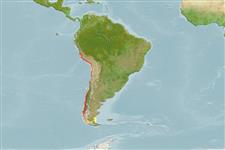Common names from other countries
Classification / Names / Names
Populärnamn | synonymer | Catalog of Fishes (gen., sp.) | ITIS | CoL | WoRMS
Environment: milieu / climate zone / depth range / distribution range
Ekologi
; djupintervall 10 - 1138 m (Ref. 87391). Temperate; 11°S - 54°S, 78°W - 68°W
Southeast Pacific and Southwest Atlantic: Chile and Peru.
Length at first maturity / Size / Vikt / Age
Maturity: Lm ? range ? - ? cm Max length : 15.0 cm CW hane/ej könsbestämd; (Ref. 78814); 11 cm CW (female)
Found on soft-bottom sublittoral habitats. Mainly epifaunal but can be considered a bioturbator as it reworks sediments. Notably disturbs the sea floor, exhibiting "sediment mining" behavior while in search of prey. Predatory (Ref. 106462).
Life cycle and mating behavior
Könsmognad | Reproduktion | Lek | Ägg | Fecundity | Larver
Members of the order Decapoda are mostly gonochoric. Mating behavior: Precopulatory courtship ritual is common (through olfactory and tactile cues); usually indirect sperm transfer.
Gorny, M. 1999. (Ref. 87391)
IUCN Red List Status (Ref. 130435)
Warning: mysqli::__construct(): (08004/1040): Too many connections in C:\Apache24\htdocs\includes\func_getlabel.php on line 46
Can't connect to MySQL database (slbapp). Errorcode: Too many connections
